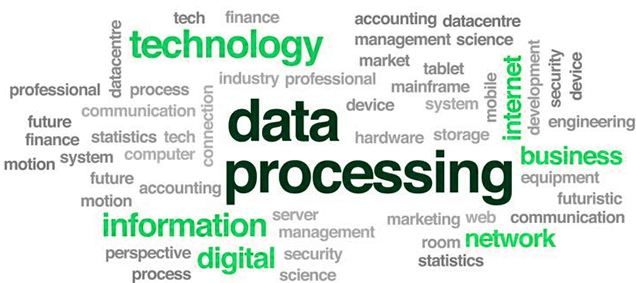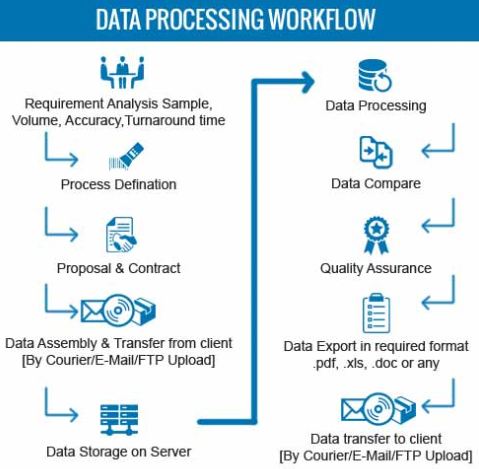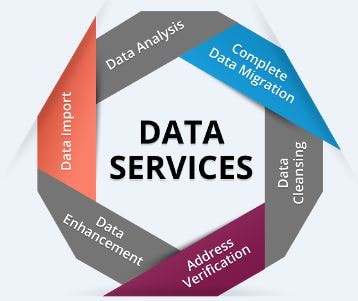Types of Data Processing With Examples
Table of Contents
Data processing is a process of manipulating data and converting it into meaningful information. Data just consist of raw facts about something and information is the meaningful form of that data and is used for making decisions.
What is Data Processing?
It can be defined as “a process of converting data into meaningful information”. Data is the input and information is the output. The data is consists of raw facts about something. Data is important but it cannot be used for decision-making.

In order to use it for making important decisions, it must be converted into meaningful information. This conversion consists of different steps and these steps collectively are known as processing. For example, when students take an examination, their marks in different subjects are stored as data.
Read This:
- Types Of Organization And Its Characteristics
- Four Conditions For Deadlock
- Interprocess Communication In OS
- Process States & Its Attributes
- Magic Call Mod APK For Android And PC
In order to assign grades to the students, marks of all subjects are processed to get the total marks. The total marks are the information, which is used to decide the grade of a particular student.
Examples
- If we want to get a list of all students who got an A grade in the examination, w will apply some processing on the marks of students. This process will give us new information in the form of the desired list. In this example, the marks of the students are the data (input) and the list of students with A grades is the information (output).
- In banks, people deposit their amount. It is stored as data in registers or computers. If the bank manager wants to know the total amount deposited in the bank, he will process all these amounts to get the sum. In this example, the amount of different people is data (input) and the sum of all amounts is the information (output).
- In the census, the data of the citizens of Pakistan are collected and stored permanently. This data can be used for different purposes like:
- To find out the literacy rate of the country
- Also, find out the total number of Ph.D.’s in the country
- To find out the poverty level in different areas of the country
This information can be used to make important decisions. For example, the government may take steps to eliminate poverty and improve the literacy rate in the country, etc.
Types Of Data Processing
Data processing is an important function that converts our data into meaningful information. In this process, different calculations are performed. In recent times, most data processing is done using computers.

Before computers, it was done by simple machines like calculators. And before calculators, everything was done by human beings manually. So, we can divide it into three levels:
Manual Data Processing
In this type, everything is done by hand. All types of calculations, processing, and operations, required to convert data into information, are performed by human beings. No machine is involved at any stage. This type was used before the invention of computers and other machines like calculators.
But some small organizations may still use this type.
Example
A bookseller runs his shop. During the day, he sells different books and gets the price of a book from the customer. He stores the record of all transactions as data in the register. At the end of the day, he wants to know the following information:
- How many books I sell today
- How much profit I got
- The number of books that remained in the stock etc.
To find the above information, he will use the data stored in the register. He will process the data using pen and paper to calculate total profit and other information. This is called manual data processing.
Mechanical Data Processing
In this type, different calculations and processing are performed with mechanical machines like a calculator. The use of mechanical machines makes it easier and faster. The chances of errors are far less than manual data processing.

Example
In the above example, it is very difficult for the bookseller to process the data all by hand. If he uses a calculator instead of just paper and pencil, the process will become very easy and will be complete in very little time.
Electronic Data Processing
In this type, all calculations and processing are performed by the computer. The input of data is given to the computer, which converts this data into information by applying the required processing. In computers, different software packages are used for data processing.
It takes far less time than other data processing techniques. The information produced by electronic data processing is more reliable. That’s why most organizations, these days, use electronic data processing rather than manual or mechanical data processing.
Example
Suppose there are 1000 students in a college. The college has to maintain a huge volume of students data. If we want to know the students who have not submitted their fees, we will have to search the forms of all students in the manual data processing. It will take so much. But if we use electronic data processing, the same task will be done in a few seconds.
Advantages
- It is more efficient.
- It is less time-consuming.
- A large amount of data can be processed easily.
- It is more reliable.
- It is more flexible and information can be presented in different styles.
- Chances of errors are less than other ways of processing.
Manual Vs Electronic Data Processing
Major differences are as follows:
| Manual | Electronic |
| Processing is performed by hand. | Processing is performed by computers. |
| It is a slow processing system. | Very fast processing system. |
| It requires more people. | It requires a few people. |
| Manual processing is less reliable. | Electronic processing is more reliable. |
| There are more chances of errors. | There are fewer chances of errors. |
| It provides less flexibility | It provides more flexibility |
| Reprocessing is very difficult and time-consuming | Reprocessing is very easy and less time consuming |
| It provides limited ways to represent information | It provides a variety of ways to represent information |
| Manual data processing becomes complex when data increases. | Electronic data processing remains easy even if data increases. |
| It required conventional knowledge of calculations. | It requires knowledge of computers and software. |
Available Links:
| 4 Types of Optical Disks | Process & Process Control Block | 3 Types of Mainframe Systems |
| 7 Types of Information Systems | What is Printer & Its Types | Database & Database Approaches |

